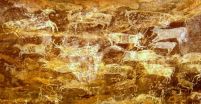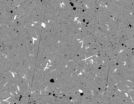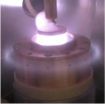(Press-News.org) WASHINGTON, D.C., October 28, 2014 – Some of mankind's earliest and most mysterious artistic achievements—including prehistoric cave paintings, canyon petroglyphs and megalithic structures such as Stonehenge—may have been inspired by the behaviors of sound waves being misinterpreted as "supernatural."
During the 168th Meeting of the Acoustical Society of America (ASA), to be held October 27-31, 2014 at the Indianapolis Marriott Downtown Hotel, Steven J. Waller, of Rock Art Acoustics, will describe several ways virtual sound images and absorbers can appear supernatural.
"Ancient mythology explained echoes from the mouths of caves as replies from spirits, so our ancestors may have made cave paintings in response to these echoes and their belief that echo spirits inhabited rocky places such as caves or canyons," explained Waller.
Just as light reflection gives an illusion of seeing yourself duplicated in a mirror, sound waves reflecting off a surface are mathematically identical to sound waves emanating from a virtual sound source behind a reflecting plane such as a large cliff face. "This can result in an auditory illusion of somebody answering you from within the rock," Waller said.
Echoes of clapping can sound similar to hoof beats, as Waller pointed out, while multiple echoes within a cavern can blur together into a thunderous reverberation that mimics the sound of a herd of stampeding hoofed animals.
"Many ancient cultures attributed thunder in the sky to 'hoofed thunder gods,' so it makes sense that the reverberation within the caves was interpreted as thunder and inspired paintings of those same hoofed thunder gods on cave walls," said Waller. "This theory is supported by acoustic measurements, which show statistically significant correspondence between the rock art sites and locations with the strongest sound reflection."
Other acoustical characteristics may have also been misinterpreted by ancient cultures unaware of sound wave theory. Waller noticed a resemblance between an interference pattern and Stonehenge, so he set up an interference pattern in an open field with just two flutes "droning the same note" to explore what it would sound like.
"The quiet regions of destructive sound wave cancellation, in which the high pressure from one flute cancelled the low pressure from the other flute, gave blindfolded subjects the illusion of a giant ring of rocks or 'pillars' casting acoustic shadows," Waller said.
He traveled to England and demonstrated that Stonehenge does indeed radiate acoustic shadows that recreate the same pattern as interference. "My theory that musical interference patterns served as blueprints for megalithic stone circles—many of which are called Pipers' Stones—is supported by ancient legends of two magic pipers who enticed maidens to dance in a circle and turned them all into stones," Waller noted.
There are several important implications of Waller's research. Perhaps most significantly, it demonstrates that acoustical phenomena were culturally significant to early humans—leading to the immediate conclusion that the natural soundscapes of archaeological sites should be preserved in their natural state for further study and greater appreciation.
"Even today, sensory input can be used to manipulate perception and lead to illusions inconsistent with scientific reality, which could have interesting practical applications for virtual reality and special effects in entertainment media," Waller said. "Objectivity is questionable, because a given set of data can be used to support multiple conclusions."
The history of humanity is full of such misinterpretations, such as the visual illusion that the sun moves around the earth. "Sound, which is invisible and has complex properties, can easily lead to auditory illusions of the supernatural," he added. "This, in turn, leads to the more general question: what other illusions are we living under due to other phenomena that we are currently misinterpreting?"
INFORMATION:Presentation #2aAA11, "Virtual sound images and virtual sound absorbers misinterpreted as supernatural objects," by Stephen J. Waller will take place on Tuesday, October 28, 2014 at 11:40 AM in Marriott 7/8. The abstract can be found by searching for the presentation number here: https://asa2014fall.abstractcentral.com/planner.jsp
ABOUT THE MEETING
The 168th Meeting of the Acoustical Society of America (ASA) will be held October 27-31, 2014, at the Indianapolis Marriott Downtown Hotel. It will feature more than 1,100 presentations on sound and its applications in physics, engineering, and medicine. Reporters are invited to cover the meeting remotely or attend in person for free.
PRESS REGISTRATION
We will grant free registration to credentialed journalists and professional freelance journalists. If you are a reporter and would like to attend, contact Jason Bardi (jbardi@aip.org, 240-535-4954), who can also help with setting up interviews and obtaining images, sound clips, or background information.
USEFUL LINKS
Main meeting website: http://acousticalsociety.org/content/fall-2014-meeting
Program and Abstracts: https://asa2014fall.abstractcentral.com/planner.jsp
Live Webcast Oct. 29: http://www.aipwebcasting.com/webcast/registration/oct2014.php
ASA's World Wide Press Room
WORLD WIDE PRESS ROOM
ASA's World Wide Press Room is being updated with additional tips on dozens of newsworthy stories and with lay-language papers, which are 300-1,200 word summaries of presentations written by scientists for a general audience and accompanied by photos, audio, and video.
LIVE MEDIA WEBCAST
A press briefing featuring a selection of newsworthy research will be webcast live from the conference the afternoon of Wednesday, October 29. A separate announcement, which includes topics and times, will be sent later this week. Register at: http://www.aipwebcasting.com/webcast/registration/oct2014.php
ABOUT THE ACOUSTICAL SOCIETY OF AMERICA
The Acoustical Society of America (ASA) is the premier international scientific society in acoustics devoted to the science and technology of sound. Its 7,000 members worldwide represent a broad spectrum of the study of acoustics. ASA publications include The Journal of the Acoustical Society of America (the world's leading journal on acoustics), Acoustics Today magazine, books, and standards on acoustics. The society also holds two major scientific meetings each year. For more information about ASA, visit our website at http://www.acousticalsociety.org
Ancient auditory illusions reflected in prehistoric art?
Although sound is invisible, evidence suggests its complex properties can easily lead to 'supernatural' auditory illusions that correspond to depictions in prehistoric cave art
2014-10-28
ELSE PRESS RELEASES FROM THIS DATE:
'Reverse engineering' materials for more efficient heating and cooling
2014-10-28
WASHINGTON, D.C., October 28, 2014 – If you've ever gone for a spin in a luxury car and felt your back being warmed or cooled by a seat-based climate control system, then you've likely experienced the benefits of a class of materials called thermoelectrics. Thermoelectric materials convert heat into electricity, and vice versa, and they have many advantages over more traditional heating and cooling systems.
Recently, researchers have observed that the performance of some thermoelectric materials can be improved by combining different solid phases -- more than one ...
Calming the plasma edge: The tail that wags the dog
2014-10-28
Experiments on the DIII-D tokamak that General Atomics operates for the U.S. Department of Energy (DOE) have demonstrated the ability of lithium injections to transiently double the temperature and pressure at the edge of the plasma and delay the onset of instabilities and other transients. Researchers conducted the experiments using a lithium- injection device developed at the DOE's Princeton Plasma Physics Laboratory (PPPL).
Lithium can play an important role in controlling the edge region and hence the evolution of the entire plasma. For example, researchers have ...
Remnants of tropical depression soaking Central America
2014-10-28
NASA's Terra satellite passed over Tropical Storm Hanna on Oct. 27 when it made landfall near the northern Nicaragua and southern Honduras border.
On Oct. 27 at 16:00 UTC (12 p.m. EDT) the MODIS instrument aboard NASA's Terra satellite captured a visible image of Tropical Storm Hanna straddling the border between Honduras and Nicaragua. The image, created by NASA's MODIS Rapid Response Team at NASA's Goddard Space Flight Center in Greenbelt, Maryland, showed strong thunderstorms on both sides of the border, bringing heavy rainfall to those area.
At 10 a.m. EDT on Oct. ...
New study uses DNA sequences to look back in time at key events in plant evolution
2014-10-28
Scientists from North America, Europe and China have published a paper in the Proceedings of the National Academy of Sciences that reveals important details about key transitions in the evolution of plant life on our planet.
From strange and exotic algae, mosses, ferns, trees and flowers growing deep in steamy rainforests to the grains and vegetables we eat and the ornamental plants adorning our homes, all plant life on Earth shares over a billion years of history.
"Our study generated DNA sequences from a vast number of distantly related plants, and we developed new ...
Ana's remnants raining and gusting in British Columbia, Canada
2014-10-28
NOAA's GOES-West satellite captured an image of post-tropical cyclone Ana's remnant clouds raining on British Columbia, Canada today, Oct. 28. Wind warnings along some coastal sections of British Columbia continued today as the storm moved through the region.
NOAA's GOES-West satellite gathered infrared data on Ana's remnant clouds and that data was made into an image by NASA/NOAA's GOES Project at NASA's Goddard Space Flight Center in Greenbelt, Maryland. In the image the remnant clouds resemble a frontal system.
Environment Canada's Meteorological Service continued ...
Breathe easier: Get your D
2014-10-28
Asthma, which inflames and narrows the airways, has become more common in recent years. While there is no known cure, asthma can be managed with medication and by avoiding allergens and other triggers. A new study by a Tel Aviv University researcher points to a convenient, free way to manage acute asthmatic episodes — catching some rays outside.
According to a paper recently published in the journal Allergy, measuring and, if need be, boosting Vitamin D levels could help manage asthma attacks. The research, conducted by Dr. Ronit Confino-Cohen of TAU's Sackler Faculty ...
Using radio waves to control the density in a fusion plasma
2014-10-28
Recent fusion experiments on the DIII-D tokamak at General Atomics (San Diego) and the Alcator C-Mod tokamak at MIT (Cambridge, Massachusetts), show that beaming microwaves into the center of the plasma can be used to control the density in the center of the plasma, where a fusion reactor would produce most of its power. Several megawatts of microwaves mimic the way fusion reactions would supply heat to plasma electrons to keep the "fusion burn" going.
The new experiments reveal that turbulent density fluctuations in the inner core intensify when most of the heat goes ...
Helping general electric upgrade the US power grid
2014-10-28
When researchers at General Electric Co. sought help in designing a plasma-based power switch, they turned to the U.S. Department of Energy's (DOE) Princeton Plasma Physics Laboratory (PPPL). The proposed switch, which GE is developing under contract with the DOE's Advanced Research Projects Agency-Energy, could contribute to a more advanced and reliable electric grid and help to lower utility bills.
The switch would consist of a plasma-filled tube that turns current on and off in systems that convert the direct current (DC) coming from long-distance power lines to the ...
European consensus on methodological recommendations for clinical studies in rare cancers
2014-10-28
One out of every five new cancer patients is diagnosed with a rare cancer, yet the clinical evidence needed to effectively treat these rare cancer patients is scarce. Indeed, conventional cancer clinical trial methodologies require large numbers of patients who are difficult to accrue in the situation of rare cancers. Consequently, building clinical evidence for the treatment of rare cancers is more difficult than it is for frequent cancers.
Dr. Jan Bogaerts, EORTC Methodology Vice Director, points out, "For rare cancers, we need alternative ways to conceive study designs ...
Lack of A level maths leading to fewer female economists
2014-10-28
A study by the University of Southampton has found there are far fewer women studying economics than men, with women accounting for just 27 per cent of economics students, despite them making up 57 per cent of the undergraduate population in UK universities.
The findings suggest less than half as many girls (1.2 per cent) as boys (3.8 percent) apply to study economics at university, while only 10 per cent of females enrol at university with an A level in maths, compared to 19 per cent of males.
"This underrepresentation of women economics degrees could have major implications ...
LAST 30 PRESS RELEASES:
Norbert Holtkamp appointed director of Fermi National Accelerator Laboratory
New agentic AI platform accelerates advanced optics design
Biologists discover neurons use physical signals — not electricity — to stabilize communication
Researchers discover that a hormone can access the brain by hitchhiking
University of Oklahoma researcher awarded funding to pursue AI-powered material design
Exploring how the visual system recovers following injury
Support for parents with infants at pediatric check-ups leads to better reading and math skills in elementary school
Kids’ behavioral health is a growing share of family health costs
Day & night: Cancer disrupts the brain’s natural rhythm
COVID-19 vaccination significantly reduces risk to pregnant women and baby
The role of vaccination in maternal and perinatal outcomes associated with COVID-19 in pregnancy
Mayo Clinic smartwatch system helps parents shorten and defuse children's severe tantrums early
Behavioral health spending spikes to 40% of all children’s health expenditures, nearly doubling in a decade
Digital cognitive behavioral treatment for generalized anxiety disorder
Expenditures for pediatric behavioral health care over time and estimated family financial burden
Air conditioning in nursing homes and mortality during extreme heat
The Alps to lose a record number of glaciers in the next decade
What makes a good proton conductor?
New science reporting guide published for journalists in Bulgaria
New international study reveals major survival gaps among children with cancer
New science reporting guide published for journalists in Turkey
Scientists develop a smarter mRNA therapy that knows which cells to target
Neuroanatomy-informed brain–machine hybrid intelligence for robust acoustic target detection
Eight SwRI hydrogen projects funded by ENERGYWERX
The Lundquist Institute and its start-up company Vitalex Biosciences Announces Strategic Advancement of Second-Generation fungal Vaccine VXV-01 through Phase 1 Trials under $40 Million Competitive Con
Fine particles in pollution are associated with early signs of autoimmune disease
Review article | Towards a Global Ground-Based Earth Observatory (GGBEO): Leveraging existing systems and networks
Penn and UMich create world’s smallest programmable, autonomous robots
Cleveland researchers launch first major study to address ‘hidden performance killer’ in athletes
To connect across politics, try saying what you oppose
[Press-News.org] Ancient auditory illusions reflected in prehistoric art?Although sound is invisible, evidence suggests its complex properties can easily lead to 'supernatural' auditory illusions that correspond to depictions in prehistoric cave art






